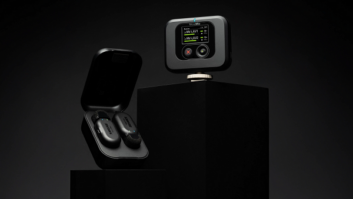New York – After seeing the success of its recent acquisition of
the Flip camcorder line, Cisco has set out to bring the same simplicity message
to home wireless networking through the launch of the Valet wireless router
line.
The company also repositioned its Linksys router family, by
scaling back the assortment while clarifying setup and usage, for more advanced
users.
Like the Flip camcorders, the family of Valet routers was
designed to be taken out of the box and set up right away with little necessary
study of the instruction manual.
The line will include the Valet ($99 suggested retail) and Valet
Plus ($149) models, the latter offering an expanded range for larger homes.
Both are 802.11n capable.
Also offered is a Valet wireless USB connector ($69), which can
be added to a computer without an internal wireless network card to connect to
the router.
The name Valet was chosen to communicate the message that “it
works for you, you don’t work for it,” the company said.
The package was designed to quickly show shoppers what is
relevant to them — showing all of the tasks that can be performed with a Wi-Fi
network in the home without getting into a lot of detail on various features
and specifications.
The Valet routers promise three steps to getting a Wi-Fi network
set up and running.
The router ships with a USB setup key that plugs into a computer,
initiating instant software setup. Settings are then saved back to the key, so
that if additional PCs in the home need to be connected to the network, the USB
key can be plugged in and network connection is made.
The software stays loaded on the computer, managing all of the
tasks that residents want to do wirelessly.
The software includes parental control features using a
one-screen dashboard that enables customized settings for each child,
regulating when they are allowed to surf the Web, differentiating between
school nights and weekends, and blocking or unblocking specific Web sites.
For those who don’t know which sites maybe inappropriate,
behind-the-scenes software allows Valet to permit or restrict access.
In the event that users need help using or setting up the
network, Cisco provides a 24/7 support line with technicians that can talk
users through problems or even enable a technician to log into the PC remotely
to take care of the set-up for them.
Another feature of the system is Guest Access, which provides a
special password that enables guests to browse the Web without giving them
access to any private data in the network.
“Just like with camcorders, this is a category that has always
been very technology driven, so we’ve listened to the things that have driven
people crazy with wireless networks and we’ve designed a category for consumers
instead of making technology for technology’s sake,” said Scott Kabat, Cisco’s
Valet marketing director.
As for retailers that have profited in the past by offering
in-home service support to set-up Wi-Fi networks, Cisco said Valet will provide
a range of new business opportunities to retailer service teams in connecting
all the various products in the home — such as TVs, Blu-ray Disc players and
video game consoles — to the in-home Wi-Fi network.
Meanwhile, Cisco is celebrating the 10th anniversary of its
Linksys router by repositioning the brand as a Cisco networking “product family,”
targeting more technically savvy users, while cutting back the assortment to
just four models.
The strategy was to reduce the number of routers and clarify the
capabilities of each on the back of the box so consumers have a clear
understanding of what to buy.
The new models, which are offered in a good-better-best scenario,
include the following:
* The Linksys E1000 ($79 suggested retail) is a standard wireless
802.11n, 2.4GHz router.
* The Linksys E2000 ($119) steps up with selectable 2.4GHz or
5GHz capability, and Gigabit ports.
* The Linksys E3000 Dual Band ($179) router offers both 2.4GHz
and 5GHz capability and Gigabit ports.
All three models will ship with a CD containing setup software
with the 802.11.1.1 network setup template in the router.
For Linux users, Linksys will offer the E2100L router ($119) with
a USB port for added storage, enabling Linux to build apps and hacks on top.
Linksys is also launching the AE1000 high-performance wireless-n
USB adapter ($69), which provides wireless-n capability to Windows desktop
computers and laptops, and offers selectable dual-band 2.4 GHz or 5 GHz support.













